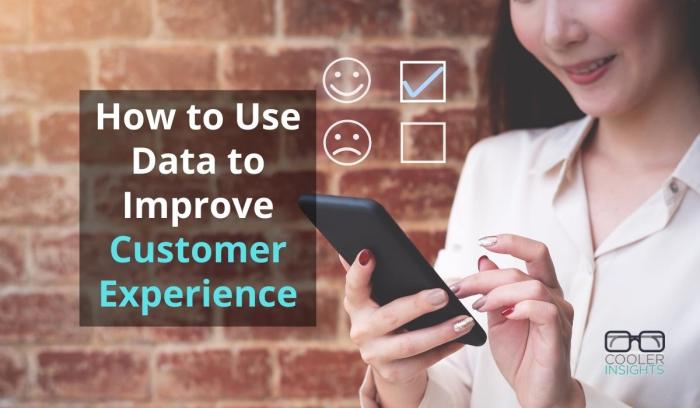Using Data to Improve Customer Experience sets the stage for revolutionizing customer satisfaction through strategic analysis and targeted actions. Dive into the world of customer data and discover the power it holds in shaping exceptional experiences.
Explore the realms of personalized interactions, predictive analytics, and innovative tools that pave the way for a customer-centric approach like never before.
Understanding Customer Data
Customer data is essential for businesses looking to improve their customer experience. By collecting and analyzing data, companies can gain valuable insights that help them understand their customers better and tailor their products and services to meet their needs.
Types of Customer Data
- Demographic information: Age, gender, location, etc.
- Purchase history: Products bought, frequency of purchases, etc.
- Behavioral data: Website interactions, response to marketing campaigns, etc.
- Feedback and reviews: Customer opinions, satisfaction levels, etc.
Each type of data provides a unique perspective on the customer, allowing businesses to create personalized experiences that resonate with their target audience.
Benefits of Data-Driven Insights
- Improved personalization: Tailoring products and services to individual preferences.
- Enhanced customer satisfaction: Meeting the needs and expectations of customers.
- Increased customer loyalty: Building strong relationships and fostering repeat business.
- Optimized marketing strategies: Targeting the right audience with relevant messaging.
Implementing Data Analytics Tools: Using Data To Improve Customer Experience
In today’s digital age, businesses have access to a plethora of data analytics tools that can help them analyze customer data and improve the overall customer experience. These tools range from basic spreadsheet software to advanced machine learning algorithms, each offering unique features, usability, and effectiveness.
Various Data Analytics Tools
- Google Analytics: A popular free tool that provides in-depth insights into website traffic, user behavior, and conversion rates.
- Tableau: A powerful data visualization tool that allows businesses to create interactive and visually appealing dashboards to analyze customer data.
- IBM Watson Analytics: An AI-powered platform that enables businesses to uncover patterns and trends in customer data through natural language processing.
Comparing Data Analytics Tools
- Features: Google Analytics is great for basic analytics, while Tableau offers advanced visualization capabilities. IBM Watson Analytics stands out for its AI-driven insights.
- Usability: Google Analytics is user-friendly for beginners, while Tableau may require some training. IBM Watson Analytics offers a more intuitive interface.
- Effectiveness: Each tool has its strengths depending on the business needs. Google Analytics is ideal for web analytics, Tableau for visualizations, and IBM Watson for advanced analytics.
Integrating Data Analytics Tools
- Define objectives: Clearly Artikel the goals you want to achieve with data analytics tools before implementation.
- Choose the right tool: Select the tool that best aligns with your objectives and budget constraints.
- Training and support: Provide employees with the necessary training to use the tool effectively and offer ongoing support.
- Continuous improvement: Regularly evaluate the performance of the tools and make adjustments to optimize their use in improving the customer experience.
Personalizing Customer Interactions

Personalizing customer interactions is crucial in creating a memorable and engaging experience for each individual. By utilizing data effectively, businesses can tailor their products, services, and communications to meet the specific needs and preferences of their customers.
Benefits of Personalizing Customer Interactions
- Increased customer satisfaction and loyalty
- Higher conversion rates and sales
- Improved customer engagement and brand perception
Examples of Successful Personalized Customer Experiences
- Amazon’s product recommendations based on past purchases and browsing history
- Netflix’s personalized movie and TV show suggestions based on viewing habits
- Spotify’s curated playlists and music recommendations based on listening history
Challenges in Maintaining Data Privacy
- Ensuring compliance with data protection regulations such as GDPR
- Securing customer data from potential breaches or cyber attacks
- Being transparent with customers about how their data is being used
Predictive Analytics for Customer Behavior

Predictive analytics involves using data, statistical algorithms, and machine learning techniques to identify the likelihood of future outcomes based on historical data. In the context of customer behavior, predictive analytics plays a crucial role in understanding and anticipating the needs and preferences of customers.
Anticipating Customer Needs
Predictive analytics can be used to analyze past customer behavior and identify patterns that can help businesses anticipate future needs. For example, an e-commerce company can use predictive analytics to recommend products to customers based on their browsing history and purchase patterns. By analyzing data such as previous purchases, time spent on specific product pages, and demographic information, businesses can personalize the shopping experience and offer relevant recommendations.
Enhancing Customer Engagement, Using Data to Improve Customer Experience
By leveraging predictive analytics, businesses can segment customers based on their behavior and preferences, allowing for targeted marketing campaigns and personalized communication. For instance, a retail store can use predictive analytics to send customized promotions to customers who are likely to make a purchase based on their past interactions with the brand. This not only enhances customer engagement but also increases the likelihood of conversion.
Ethical Considerations
While predictive analytics can provide valuable insights into customer behavior, there are ethical implications to consider. The use of personal data to make predictions about individuals’ preferences and behaviors raises concerns about privacy and data security. Businesses must ensure transparency in their data collection practices and obtain consent from customers before using their data for predictive analytics. Additionally, there is a risk of algorithmic bias, where predictive models may unintentionally discriminate against certain groups based on historical data.
It is crucial for businesses to regularly evaluate and monitor their predictive analytics models to mitigate these risks and ensure fair and ethical use of customer data.